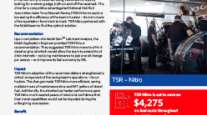Diesel, Gasoline Averages Dip, Ending Monthlong Increase
This story appears in the Nov. 16 print edition of Transport Topics.
U.S. retail diesel and gasoline price averages reversed a monthlong string of increases last week, as diesel dipped 0.7 cent to $2.801 a gallon and gas declined 2.8 cents to $2.666, the Department of Energy reported.
Between Oct. 5 and Nov. 2, the price of each fuel jumped 22.6 cents a gallon, leaving diesel at $2.808, its highest level in nearly a year.
“The real story is that the prices of both fuels have essentially stabilized, following the stabilizing of crude oil prices,” Tancred Lidderdale, senior economist at DOE’s Energy Information Administration, told Transport Topics.
“Crude abruptly rose by more than $10 a gallon during two weeks in October and that translates into 20-to-29-cents in retail price increases once the increases work their way through the supply chain,” Lidderdale said. “Most of those retail increases did come two to three weeks after crude shot up, and there’s been little movement since.”
Crude oil closed at $69.57 on the New York Mercantile Exchange on Oct. 7 and rose to a high of $81.37 on Oct. 21, Bloomberg News reported.
“Crude oil dropped back down to the $80 a barrel range a few days after its high and has been trading in the $76 to $80-a-barrel range since,” Lidderdale said. “Retail prices likewise have remained in the same range.”
Lidderdale explained that slight dips in crude could have accounted for the drop in retail prices last week, but dozens of other factors could have been involved as well, when discussing such minor shifts.
“Basically, prices will remain about where they are until some good news or bad news sends crude sharply in one direction or another,” he said.
Following the latest price moves at the pump, diesel is 14.3 cents a gallon cheaper than it was a year ago, while gasoline is 44.2 cents higher, DOE said after its weekly survey of fueling stations.
American Trucking Associations estimates that the U.S. motor carriers burn 752 million gallons of diesel weekly and 285 million gallons of gasoline.
At those rates, truckers paid $107.5 million less during the week for diesel than they did a year ago but had to pay $126 million more for their gasoline.
One fleet owner said that the recent four-week run-up in diesel prices hurt his business and that the slight drop last week would do little to help.
“We get most of our fuel in the West, where diesel is always higher, even though we’re a 48-state company, and a good number of our drivers have had to pay $3 a gallon in recent weeks in California,” Charles Kinsey, owner of Blue Collar Logistics, Greeley, Colo., told TT. “Brokers base their surcharges on the national average, which is running 20 cents cheaper, so we get hit hard there.”
Diesel sold on average for $2.909 on the West Coast last week, DOE said.
Blue Collar Logistics runs about 50 tractors, 35 of which are company-owned, and operates about 80 trailers carrying mostly fresh meat and produce.
Meanwhile, EIA last week issued its new short-term energy outlook, which predicted that crude oil would average $77 a barrel between October and March. That price is $7 higher than its previous forecast.
“Projected annual average diesel fuel retail prices are $2.48 and $2.94 per gallon, respectively, in 2009 and 2010,” the report said.
EIA said projected higher heating oil costs also would drive up diesel prices.




